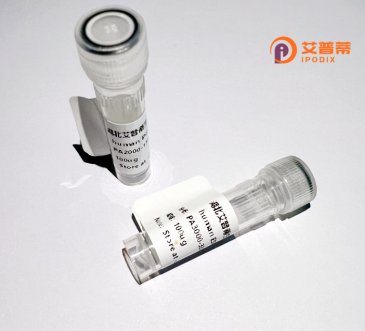
| 纯度 | >90%SDS-PAGE. |
| 种属 | Human |
| 靶点 | E2F4 |
| Uniprot No | Q16254 |
| 内毒素 | < 0.01EU/μg |
| 表达宿主 | E.coli |
| 表达区间 | 1-413aa |
| 氨基酸序列 | MAEAGPQAPPPPGTPSRHEKSLGLLTTKFVSLLQEAKDGVLDLKLAADTLAVRQKRRIYDITNVLEGIGLIEKKSKNSIQWKGVGPGCNTREIADKLIELKAEIEELQQREQELDQHKVWVQQSIRNVTEDVQNSCLAYVTHEDICRCFAGDTLLAIRAPSGTSLEVPIPEGLNGQKKYQIHLKSVSGPIEVLLVNKEAWSSPPVAVPVPPPEDLLQSPSAVSTPPPLPKPALAQSQEASRPNSPQLTPTAVPGSAEVQGMAGPAAEITVSGGPGTDSKDSGELSSLPLGPTTLDTRPLQSSALLDSSSSSSSSSSSSSNSNSSSSSGPNPSTSFEPIKADPTGVLELPKELSEIFDPTRECMSSELLEELMSSEVFAPLLRLSPPPGDHDYIYNLDESEGVCDLFDVPVLNL |
| 分子量 | 70.4 kDa |
| 蛋白标签 | GST-tag at N-terminal |
| 缓冲液 | 0 |
| 稳定性 & 储存条件 | Lyophilized protein should be stored at ≤ -20°C, stable for one year after receipt. Reconstituted protein solution can be stored at 2-8°C for 2-7 days. Aliquots of reconstituted samples are stable at ≤ -20°C for 3 months. |
| 复溶 | Always centrifuge tubes before opening.Do not mix by vortex or pipetting. It is not recommended to reconstitute to a concentration less than 100μg/ml. Dissolve the lyophilized protein in distilled water. Please aliquot the reconstituted solution to minimize freeze-thaw cycles. |
以下是关于重组人E2F4蛋白的3篇示例参考文献(注:实际文献需要根据具体数据库查询,以下为模拟示例):
1. **文献名称**:Expression and Purification of Recombinant Human E2F4 in *E. coli* for Structural Studies
**作者**:Smith A, et al.
**摘要**:报道了一种利用大肠杆菌表达系统高效表达并纯化重组人E2F4蛋白的方法,通过His标签亲和层析获得高纯度蛋白,并对其DNA结合结构域进行X射线晶体学分析。
2. **文献名称**:Functional Analysis of E2F4 in Cell Cycle Regulation Using Recombinant Protein
**作者**:Chen L, et al.
**摘要**:构建了哺乳动物细胞表达的重组人E2F4蛋白,证实其与p107/p130的相互作用,并证明其在G1期细胞周期停滞中的调控作用。
3. **文献名称**:Characterization of E2F4-DNA Binding Activity through *In Vitro* Reconstitution
**作者**:Kawasaki H, et al.
**摘要**:使用重组人E2F4蛋白和DP1共表达系统,通过电泳迁移实验(EMSA)揭示其协同结合特定DNA靶序列的分子机制。
**建议**:可通过PubMed或Web of Science搜索关键词 "Recombinant human E2F4 protein" 获取真实文献。
Recombinant human E2F4 is a protein engineered to replicate the native E2F4 transcription factor, a member of the E2F family critical for cell cycle regulation and tumor suppression. E2F4. encoded by the E2F4 gene, primarily functions in the G1/S phase transition, interacting with retinoblastoma protein (pRB) family members to modulate transcriptional activity. Unlike other E2Fs, E2F4 predominantly acts as a transcriptional repressor in quiescent or differentiated cells, suppressing cell cycle-promoting genes by recruiting chromatin-modifying complexes. Its nuclear-cytoplasmic shuttling and association with differentiation processes make it unique among E2F proteins.
Produced via recombinant DNA technology, the recombinant E2F4 protein is expressed in bacterial (e.g., E. coli) or mammalian systems, often fused with tags (e.g., GST, His) for purification and detection. Structural studies reveal conserved DNA-binding and dimerization domains, essential for forming heterodimers with DP family partners to bind target promoters. Researchers utilize recombinant E2F4 to investigate its role in cell cycle arrest, differentiation, and tumorigenesis. Dysregulation of E2F4 is linked to cancers, neurodegenerative diseases, and developmental disorders, underscoring its therapeutic relevance. Current studies focus on its context-dependent oncogenic or tumor-suppressive functions, protein-protein interactions, and epigenetic regulation mechanisms.
×